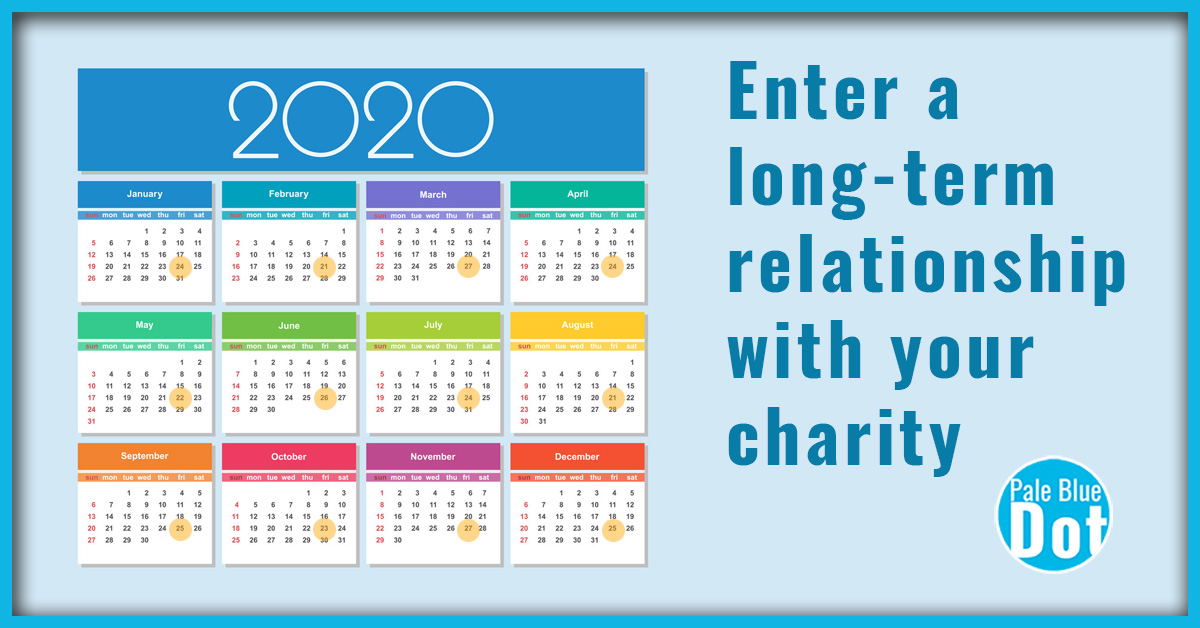Today, we’re going to take a moment to think through when we give to charity. The timing of our charitable giving for many people falls into a pretty narrow pattern: we engage with our charities once a year, some time around November and December, and then fall back into silence until next year.
Why do most of us give that big one-time gift at year end?
The most popular time for giving lands between Thanksgiving and New Years Day. We have a bunch of really good reasons for this pattern:
-
We know how much savings we have left over after our annual expenses, so we can decide how much out of that to give to charity;
-
We feel compelled to undertake an act of charity aligning to either a religious holiday or a general secular season of giving;
-
We are swayed by the sudden uptick of marketing from charitable organizations at home and in our workplaces, imploring us to open our wallets;
-
We got our year end bonuses, and we feel inspired to share the wealth; or
-
We know that if we make a donation now, we will get some of it back in our tax returns next spring.
This trend is so exaggerated that many charities receive a third or more of their annual donations during that one short period. Charity budgets have adapted over time to reflect this behaviour. They try to use historical donations at this time of year to predict future seasonal givings. Sometimes these forecasts line up with reality, and sometimes they don’t. Sadly, these projections are just estimates, and until the donations come in, the charities really don’t know what to expect. The situation is a lot like you waiting for your tax refund, except the difference is, they may or may not get the donations when the time comes, and the tax rules are reasonably predictable.
How much debt would you rack up in a year, hoping for a big year-end bonus to pay for it? Charities experience the same kind of pressure. The needs that drive these charitable organizations exists year round. You’re asking them to support a cause year-round based on an influx of funding that occurs in one season. To their credit, many of them do this remarkably successfully, in spite of the fact that they are all competing for a thin slice of our mindshare in a highlight competitive landscape. Charities that have been historically well-supported are better positioned to attract our attention… but it is still a lot like a feeding frenzy, and not everyone walks away with a full belly.
Donors and charities have settled into the year-end pattern: we get one date, once a year, and then most of us walk away. There is an alternative.
What kind of a change are we talking about?
You can help your favourite charities achieve their mission in a more dependable way. I’m going to suggest that you change how often you donate.
If you normally give $1,000 each year in December, please consider stepping up the frequency. Four quarterly gifts of $250 space out the income received by that charity over the whole year. You could give $83.33 a month, or $19.12 a week. Worried about fluctuations in your income? Split the difference. Pick the amount that you are sure you can give each year, and get it set up as a recurring donation on a quarterly, monthly, or weekly cycle. Then, at year end, you can give an additional one-time gift when you are sure how much you have left over for charitable giving.
For those of you who know me, you know I tend to re-introduce math at odd moments. This is one of them. While I have emphasized the value of increased frequency, there are limits. Daily gifts are cute, but the transaction costs can mount up for the charity on the receiving end, reducing the overall benefit received. Aim for weekly or monthly cycles where possible.
More and more charities have recurrent giving programs, and most of them are really quick and easy to work into your life:
- You select the frequency of your donation;
- You choose the amount your would like to give each period; and
- Each period, the amount will be automatically contributed without you needing to do anything at all, the same as pre-authorized bill payments to Netflix or your cell phone carrier.
Increased frequency has benefits for both donor and charity
The smaller charities experience significant variation in donation revenue from month to month, and year to year. Get yourself set up as a recurring donor. Now what there are a variety of online fundraising systems, it has become an option for nonprofits of all sizes to accept monthly recurring donations. When a donor signs up for a recurring donation online, there are no checks to mail and no reminders needed; much of the expense and hassle has been eliminated. If you commit to monthly giving, in addition to giving the charity a steady and predictable source of funding, you bring these additional benefits:
- Reduced transactional costs. Setting up a recurring payment reduces fees because the administrative overhead associated with processing one-time cheques was eliminated;
- Reduced marketing costs to new donors as confidence in their enrolled donors increases.
- Simplified administration by using these automated systems through to tax receipting;
- Retained focus on achieving their charitable mission. Your regular donations help charities plan future projects and initiatives without worrying if enough funds will come in to do the work.
There are definite advantages for you, as a donor, to enrol in a monthly giving campaign:
- It is a more accessible entry to charity. For many younger donors or those with variable income over the year, smaller recurring donations fit their lifestyle batter, and still add up to a significant donation each year;
- It is convenient. Once set up, there is no need to spend time each month ensuring that the payments occur. Many systems offer additional features to allow you to change your contribution amounts or frequencies as your financial picture evolves, as well as the option to receive a single tax receipt for the year, or receipts for each transaction;
- You can become increasingly strategic on your giving. While giving to charity does feel good, it feels even better when you take the time to prioritize where and how you want to make a difference. You can start looking at your investments in various varieties the way you would look at your investment portfolio, balancing the mix in what you support to better align to your value structure;
- You can plan your own finances better. Your scheduled gifts not only help the charity plan, but they help you budget your own finances as well, instead of trying to assemble the gift in a mad dash at year end, in between all of the other activity going on at year end; and
- You get access to special programs. Many charitable organizations have special programs for recurring donors that provide them with special updates, newsletters, or reports.
Does it really make that much of a difference?
Yes. Absolutely, YES. When you set yourself up as a recurring donor with a charity you support, you are moving beyond a one-time interaction into a longer relationship. Now you will be able to see how your donations are making a difference over time. You will be given additional opportunities to become more involved in the charity, not just by donating funds, but by becoming a volunteer or an an ambassador for their story to your friends and family.
My Grandmother has participated in many forms of charity over her life, but the one that seems to have meant the most to her was setting up recurring donations that sponsored several children over her lifetime. What she remembers most is the one gift that led to a lasting relationship with the child, who she supported from elementary school, to high school, all the way through his medical school. That man is now a doctor supporting the community he grew up in, and is giving back to the next generation of children. What my grandmother remembers wasn’t that she gave however many thousands of dollars over the decades: she remembers the letters that boy sent her, year after year, as he grew into a man with his own dedication to charitable work.
These long-term relationships mean a lot to the charities, and to those who donate to them. Interestingly, even though monthly donors give smaller amounts per gift, on average they tend to add up to more than the average one-time gift, and they tend to form lasting relationships with their charities. These higher retention rates year over year mean help the charity to spend less on marketing to win over more one-time donors, making the donations even more effectively directed at the core work of the charity. These longer relationships enrich the lives of the donors
Giving is more fun and much more meaningful when you see the difference your donations are making over time. Don’t be an entry on a single page of your favourite charity’s story: live the story with them over the years, and grow together over time.

